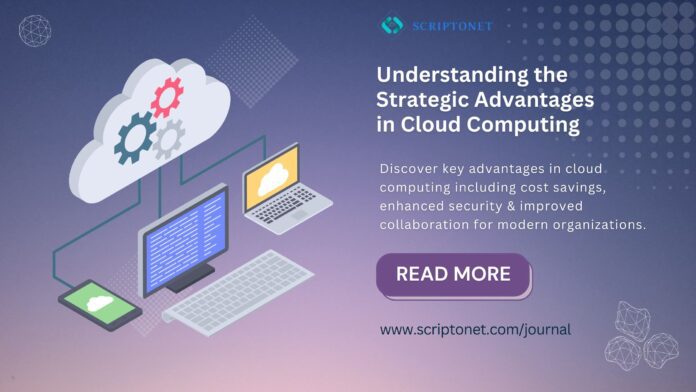Introduction
Cloud Computing has transformed how businesses & individuals access, store & manage their digital resources. This revolutionary technology shifts computing services from traditional on-premise infrastructure to internet-based platforms managed by third-party providers.
The advantages in cloud computing extend far beyond simple cost savings. Organizations worldwide discover that cloud solutions offer unprecedented flexibility, enhanced security & improved collaboration capabilities. Understanding these benefits helps decision-makers evaluate whether cloud migration aligns with their strategic goals.
This comprehensive guide explores the multifaceted advantages in cloud computing from historical, practical & diverse perspectives. We examine both the compelling benefits & potential limitations to provide a balanced view of this transformative technology.
Historical Evolution of Cloud Computing Benefits
Cloud Computing emerged from the need to maximize computing resources & reduce infrastructure costs. Early adopters in the 2000s discovered that shared computing resources delivered significant economic advantages.
The advantages in cloud computing became apparent as companies like Amazon Web Services (AWS) pioneered scalable infrastructure models. Traditional businesses spent enormous amounts on hardware that remained underutilized for most operating hours. Cloud solutions addressed this inefficiency by allowing organizations to pay only for resources they actually consume.
Historical data shows that early cloud adopters achieved cost reductions of twenty (20) to thirty (30) percent compared to traditional infrastructure. These savings came primarily from eliminating capital expenditures on hardware & reducing IT staff requirements for maintenance tasks.
The evolution continued as cloud providers enhanced security measures & compliance standards. What began as basic storage solutions expanded into comprehensive platforms offering advanced analytics, machine learning & enterprise applications.
Core Financial Advantages in Cloud Computing
Cost Reduction & Budget Flexibility
The most immediate advantages in cloud computing appear in financial statements. Organizations eliminate substantial capital investments in servers, storage systems & networking equipment. Instead, they adopt operating expense models that align costs with actual usage.
Consider a manufacturing company that experiences seasonal demand fluctuations. Traditional infrastructure requires purchasing equipment to handle peak loads, leaving resources idle during slower periods. With the use of cloud computing, this business can scale up its resources during peak times and then scale them down, only paying for what they utilize.
Maintenance costs disappear from internal budgets. Cloud providers handle hardware updates, security patches & system monitoring. This shift eliminates the need for specialized IT staff & reduces overhead expenses significantly.
Predictable Pricing Models
Cloud service providers provide a range of pricing options to improve financial planning. Monthly subscriptions, pay-per-use models & reserved instance pricing give organizations multiple options to optimize their spending.
The advantages in cloud computing include transparent cost structures. Unlike traditional infrastructure where hidden costs accumulate through maintenance, upgrades & unexpected failures, cloud services provide clear pricing that simplifies financial planning.
Operational & Performance Benefits
Scalability & Resource Management
Modern businesses face unpredictable demand patterns. The advantages in cloud computing shine brightest during these challenging scenarios. Organizations can instantly provision additional computing power, storage capacity or network bandwidth without lengthy procurement processes.
A software business may see an unexpected spike in the number of users while releasing a new program. Traditional infrastructure could take weeks or months to accommodate this growth. Cloud platforms enable immediate scaling, ensuring optimal performance regardless of user volume changes.
Automatic scaling features monitor system performance & adjust resources without human intervention. This capability prevents both resource shortages that degrade performance & resource waste that increases costs unnecessarily.
Enhanced Reliability & Uptime
Redundancy and disaster recovery solutions are major investments made by cloud providers.The advantages in cloud computing include access to enterprise-level reliability that would be prohibitively expensive for most organizations to implement independently.
Multiple data centers ensure service continuity even during hardware failures or natural disasters. Geographic distribution of resources protects against regional outages & provides faster response times for users in different locations. Service Level Agreements (SLA)s typically guarantee 99.9% percent uptime or higher. This reliability surpasses what most organizations achieve with internal infrastructure.
Security & Compliance Advantages
Professional Security Management
The benefits of cloud computing also include improved security postures. Major cloud providers employ security specialists, implement advanced threat detection systems & maintain compliance with numerous industry standards. Small & Medium Businesses (SMB)s gain access to enterprise-level security measures they couldn’t afford independently. These include twenty-four (24) hour monitoring, automated threat response & regular security audits performed by certified professionals.
Data encryption, both in transit & at rest, becomes standard practice rather than an expensive add-on. Multi-Factor Authentication (MFA) & Identity & Access Management (IAM) integrate seamlessly into cloud environments.
Regulatory Compliance Support
Industries with strict compliance requirements benefit significantly from cloud solutions. The advantages in cloud computing include built-in compliance features for standards like HIPAA, SOX, GDPR & others.
Cloud providers maintain and regularly audit compliance certifications. This shared responsibility model reduces the compliance burden on organizations while ensuring adherence to regulatory requirements.
Collaboration & Accessibility Benefits
Remote Work Enablement
The advantages in cloud computing became particularly evident during global remote work transitions. Cloud-based apps facilitate smooth collaboration regardless of where employees are located.
Teams access identical resources whether working from corporate offices, home offices or mobile locations. Version control, real-time editing & communication tools integrate naturally in cloud environments.
Document sharing becomes instantaneous & secure. Traditional methods involving email attachments or physical storage devices create version conflicts & security risks that cloud solutions eliminate.
Cross-platform Compatibility
Cloud applications typically work across different operating systems & device types. Because of this flexibility, businesses no longer need to standardize on particular software or hardware platforms.
Workers access the same company resources on the devices of their choice. This flexibility improves job satisfaction & reduces equipment costs for organizations.
Limitations & Considerations
Internet Dependency
Cloud computing requires a reliable internet connection. Organizations in areas with poor connectivity may experience service disruptions that affect productivity.
Bandwidth costs can become significant for organizations that frequently transfer large data volumes. These ongoing expenses must be factored into total cost calculations.
Data Control Concerns
Some organizations express concerns about storing sensitive Data on external Servers. Regulatory requirements in certain industries may limit cloud adoption options.
Vendor lock-in presents another challenge. Migrating between cloud providers can be complex & expensive, potentially limiting future flexibility.
Performance Variables
Shared resources in public cloud environments may experience performance variations during peak usage periods. Applications requiring consistent performance might need private cloud solutions that increase costs.
Conclusion
The advantages in cloud computing represent a fundamental shift in how organizations approach information technology. Financial benefits, operational flexibility, enhanced security & improved collaboration capabilities make cloud solutions attractive for most modern businesses.
However, successful cloud adoption requires careful planning & realistic assessment of organizational needs. Internet connectivity, data sensitivity & performance requirements all influence the optimal cloud strategy.
Organizations that thoroughly evaluate their requirements & choose appropriate cloud solutions typically achieve significant benefits in cost reduction, operational efficiency & business agility.
Takeaways
- The advantages in cloud computing deliver measurable value across multiple business dimensions. Cost reduction through eliminated capital expenditures & reduced maintenance requirements provides immediate financial benefits.
- Operational flexibility allows businesses to react swiftly to shifting market conditions. Scalability features ensure optimal performance during demand fluctuations while preventing resource waste during quieter periods.
- Security enhancements through professional management & compliance support reduce risk while maintaining regulatory adherence. Collaboration tools enable productive remote work & cross-platform compatibility.
- Successful cloud adoption requires understanding both benefits & limitations to make informed decisions aligned with organizational goals.
Frequently Asked Questions (FAQ)
What are the primary advantages in cloud computing for Small Businesses?
Small businesses benefit most from cost reduction & access to enterprise-level capabilities. Cloud computing eliminates large capital investments in hardware while providing professional security management & reliable backup systems that would otherwise be unaffordable.
How do the advantages in cloud computing compare to traditional Infrastructure?
Cloud computing typically offers lower total costs, better scalability & enhanced security compared to traditional infrastructure. However, organizations with consistent resource requirements & strong internal IT capabilities might find traditional infrastructure more cost-effective in specific scenarios.
Can Organizations adopt cloud computing without compromising Data Security?
Yes, major cloud providers implement security measures that often exceed what organizations achieve independently. Encryption, Multi-factor Authentication (MFA) & professional monitoring enhance security beyond typical internal capabilities, though organizations must carefully evaluate provider security standards.
Which industries benefit most from cloud computing?
Industries with variable demand patterns, remote work requirements or limited it resources benefit significantly. Software development, healthcare, education & retail commonly achieve substantial advantages, though virtually all industries can benefit from appropriate cloud strategies.
How quickly can Organizations realize advantages in cloud computing after Migration?
Most organizations see immediate cost benefits & operational improvements within the first month after migration. However, full advantage realization typically occurs over three (3) to six (6) months as teams adapt to new workflows & optimize their cloud usage patterns.


